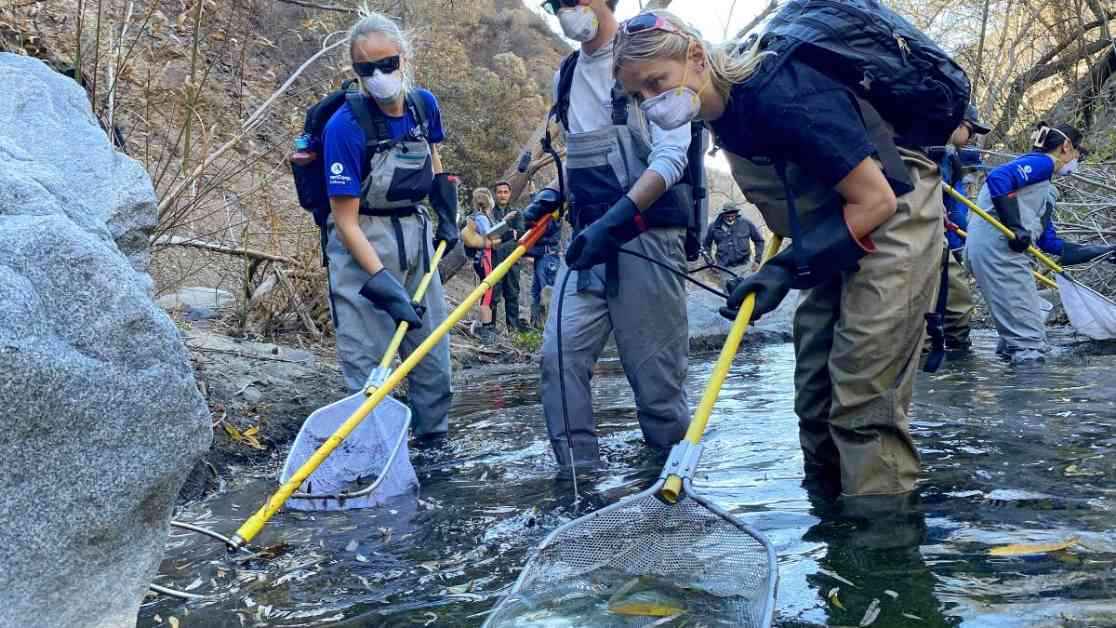Trout Rescued from Palisades Fire Burn Scar Face Lengthy Healing Process – An Inside Look
In the wake of the devastating Palisades fire, a critical mission unfolded to rescue a population of endangered steelhead trout in the Santa Monica Mountains. The delicate ecosystem was threatened by ash from the fire, compromising the water quality of Topanga Creek, the last refuge for these fish. The urgency of the situation was underscored by the impending rain, which posed a risk of debris flows that could further endanger the trout.
On January 23, a dedicated team of biologists embarked on a challenging rescue operation. Their goal was to stun the trout with an electric current, swiftly transport them in buckets, and relocate them to safety before the storm hit. The clock was ticking, and every moment counted to minimize stress on the endangered fish. The stakes were high, and the pressure was palpable as 271 Southern California steelhead trout were successfully rescued and taken to a hatchery in Fillmore.
The success of the rescue operation was a cause for celebration, as it represented a significant portion of the remaining steelhead population. Rosi Dagit, the principal conservation biologist for the Resource Conservation District of the Santa Monica Mountains, expressed her amazement and gratitude at the outcome of the operation. The narrow escape was a testament to the dedication and expertise of the rescue teams, who worked tirelessly to save these precious fish from imminent disaster.
Challenges and Solutions in Habitat Restoration
The recent fish rescues in the Santa Monica Mountains shed light on the broader challenges facing endangered species in the region. The decline in suitable habitat over the past century, coupled with the increasing frequency of wildfires, has put immense pressure on fragile ecosystems. The aftermath of the Palisades fire highlighted the urgent need for habitat restoration and conservation efforts to safeguard vulnerable species like the steelhead trout and tidewater gobies.
Kyle Evans, an environmental program manager for the California Department of Fish and Wildlife, emphasized the importance of long-term solutions for habitat restoration. Removing barriers like the Rindge Dam and the Matilija Dam, along with invasive species, is crucial to creating a sustainable environment for these endangered fish. The delicate balance between habitat preservation and species conservation requires a proactive approach to ensure the survival of these at-risk populations.
The future of the steelhead trout and tidewater gobies hinges on innovative strategies and collaborative efforts to restore their natural habitats. Dagit, a key figure in the recent rescue operations, stressed the need for creative solutions to enhance the resilience of these species in the face of ongoing environmental challenges. By exploring alternative approaches like captive breeding and barrier removal, conservationists aim to increase the redundancy and viability of these fragile populations.
Looking Ahead: A Path to Recovery
As the rescued fish acclimate to their new surroundings, the focus shifts to their long-term well-being and eventual return to the wild. Plans are underway to reintroduce the steelhead trout to a suitable stream in Santa Barbara County, offering hope for their continued survival and recovery. In the meantime, efforts are underway to provide a safe and nurturing environment for the fish in captivity, ensuring their health and well-being during this transition period.
The challenges posed by the Palisades fire underscore the interconnectedness of human communities and natural ecosystems. As Los Angeles and surrounding areas recover from the devastation of recent wildfires, the importance of habitat conservation and species protection comes into sharp focus. Evans and his team at the California Department of Fish and Wildlife are committed to supporting both people and fish, recognizing the vital role of healthy ecosystems in sustaining local communities.
In the face of adversity, the resilience of endangered species like the steelhead trout and tidewater gobies serves as a reminder of the fragility and beauty of our natural world. By working together to preserve and protect these vulnerable populations, we can ensure a brighter future for all who call the Santa Monica Mountains home.


